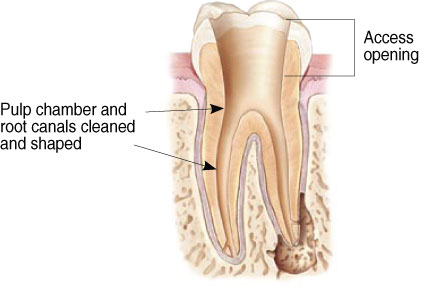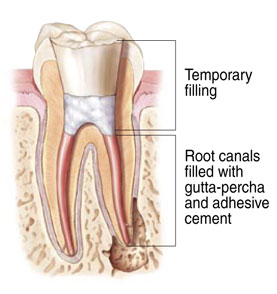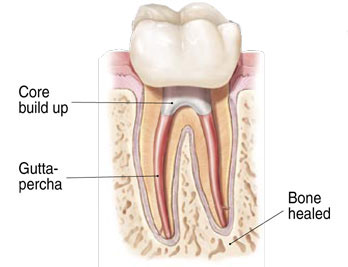| |

What is non-surgical endodontic treatment?
This is a method of treating the inside of the tooth, also known as a root canal treatment. It is one of the most common dental procedures that can be performed to prevent tooth loss. |
|
To help you understand endodontic treatment, we would like to familiarize you with the anatomy of your tooth. Inside your tooth, under the white tooth enamel and the hard layer of tooth, called dentin, is a soft tissue known as the pulp. The pulp consists of blood vessels, nerves and connective tissue which help to create the surrounding hard tissues of the tooth during development.
The pulp can be found in the center of the tooth and can extend all the way to the tip of the roots where it connects to the tissues surrounding the root. The pulp has a very important role during a tooth’s development. However, a tooth that has reached full maturity can survive without the pulp, because it continues to receive nourishment by the surrounding tissues. |
|
Why do I need endodontic treatment?
If the soft tissue inside the root canal of a tooth becomes inflamed or infected, then a root canal treatment is necessary. There can be a variety of factors that cause the inflammation or infection such as: repeated dental procedures on the tooth, deep decay, crack s or chips in tooth. |
|
What are the signs of needing endodontic treatment?
Indication signs to look for include pain, tenderness to touch and chewing, prolonged sensitivity to hot or cold, discoloration of the tooth, swelling of the surrounding tissue, and drainage. Symptoms may not always be present.
How does endodontic treatment save the tooth?
The endodontist removes the inflamed or infected pulp, carefully cleans and shapes the inside of the canal, a channel inside the root, then fills and seals the space. Afterwards, you will return to your dentist, who will place a crown or other restoration on the tooth to protect and restore it to full functions. After restoration, the tooth continues to function like any other tooth.
Will I feel pain during or after the procedure?
Many endodontic procedures are performed to relieve the pain of toothaches caused by pulp inflammation or infection. With modern techniques and anesthetics, most patients report that they are comfortable during the procedure. For the first few days after treatment, your tooth may feel sensitive, especially if there was pain or infection before the procedure. This discomfort can be relieved with over-the-counter or prescription medications. Follow your endodontic's instructions carefully. Your tooth may continue to feel slightly different from your teeth for some time after your |
| endodontic treatment is completed. However, if you have severe pain or pressure or pain that lasts more than a few days, call your endodontist. |
|
Endodontic Procedure
Endodontic treatment can often be performed in one or two visits and involves the following steps: |
1. The endodontist examines and x-rays the tooth, then administers local anesthetic. After the tooth is numb, the endodontist places a small protective sheet called a “dental dam” over the area to isolate the tooth and keep it clean and free of saliva during the procedure.

2. The endodontist makes an opening in the crown of the tooth. Very small instruments are used to clean the pulp from the pulp chamber and root canals and to shape the space for filling.

3. After the space is cleaned and shaped, the endodontist fills the root canals with a biocompatible material, usually a rubber-like material called “gutta-percha.” The gutta-percha is placed with an adhesive cement to ensure complete sealing of the root canals. In most cases, a temporary filling is placed to close the opening. The temporary filling will be removed by your dentist before the tooth is restored.

4. After the final visit with your endodontist, you must return to your dentist to have a crown or other restoration placed on the tooth to protect and restore it to full function

|
|
How much will the procedure cost?
The cost varies depending on how complex the problem is and which tooth is affected. Molars are more difficult to treat, the fee is usually more. Most dental insurance policies provide some coverage for endodontic treatment.
Generally, endodontic treatment and restoration of the natural tooth are less expensive than the alternative of having the tooth extracted. An extracted tooth must be replaced with a bridge or implant to restore chewing function and prevent adjacent teeth from shifting. These procedures tend to cost more than endodontic treatment and appropriate restoration. With root canal treatment you save your natural teeth and money. |
| |
|
|
|
